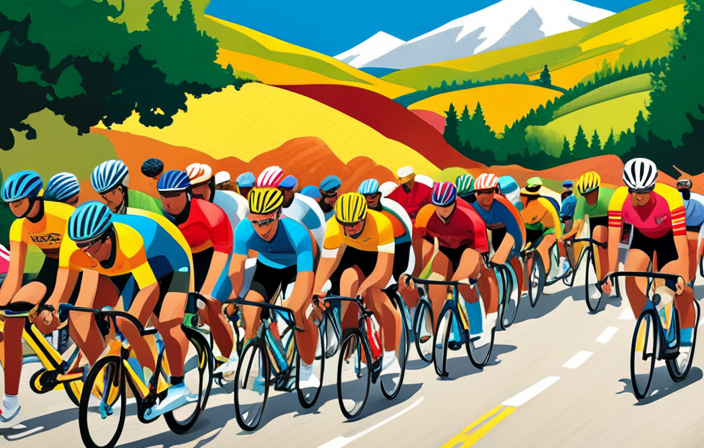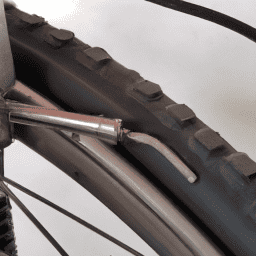Bicycle races are like an exhilarating roller coaster ride, filled with excitement and adrenaline. From the renowned Tour de France to high-speed criterium races, these events highlight the talent, quickness, and stamina of cyclists.
In this article, I will explore the various types of bicycle races and what makes each one unique. So hop on your virtual saddle and join me as we embark on a journey through the exhilarating world of bicycle racing.
Key Takeaways
- BMX racing promotes physical fitness, bike handling skills, discipline, perseverance, and sportsmanship.
- Endurance races are grueling challenges that test participants physically and mentally, requiring careful planning and pacing.
- Gran Fondos are mass participation events for cycling enthusiasts, offering challenging routes and the opportunity to ride with fellow cyclists.
- Participating in bicycle races like Gran Fondos, BMX racing, and endurance races can provide a sense of accomplishment, personal growth, improved cycling skills, physical fitness, mental resilience, problem-solving skills, and social connections with other cyclists.
Tour de France: The Most Prestigious and Iconic Bicycle Race
The Tour de France is the most prestigious and iconic bicycle race. It has a rich history and holds great significance in the world of cycling.
First held in 1903, the Tour de France has become a symbol of endurance and determination. It covers a distance of over 3,500 kilometers and is divided into 21 stages, taking the riders through various terrains and challenging conditions.
The race attracts top cyclists from around the world, all vying for the coveted yellow jersey. The challenges faced by the cyclists include grueling mountain climbs, treacherous descents, and unpredictable weather. The Tour de France is not only a test of physical strength but also mental fortitude and strategic planning.
Transitioning to criterium races, these exciting and fast-paced city cycling competitions offer a unique contrast to the endurance required in the Tour de France.
Criterium Races: Exciting and Fast-Paced City Cycling Competitions
Get ready to experience the excitement and fast-paced action of criterium races. You’ll be riding through the city at high speeds, navigating tight corners, narrow roads, and fast straightaways. These urban races are known for their thrilling atmosphere and challenging courses. Criterium races are typically held on short, closed-loop circuits that loop through city streets. The exhilarating ride requires quick reflexes and excellent bike handling skills. Spectators line the streets, creating a vibrant and energetic atmosphere as they cheer on the cyclists. City cycling competitions like criterium races showcase the sport of cycling to a wider audience and bring the action right to the heart of urban areas.
Now, let’s transition to the subsequent section about road races: long-distance challenges on open roads.
Road Races: Long-Distance Challenges on Open Roads
Road races are demanding tests of endurance and skill, with cyclists covering long distances on open roads. These long-distance cycling events present a unique set of challenges for the participants. Not only do they have to navigate through varying terrains, but they also have to contend with factors such as wind resistance and road conditions. Road races often take place on scenic routes, showcasing the beauty of the surrounding landscape. Cyclists must pace themselves strategically, as these races can last for several hours. Additionally, they need to be aware of their competitors and make tactical decisions to gain an advantage. The physical demands of road races require cyclists to be in peak condition and possess excellent bike handling skills. Transitioning to time trials: individual races against the clock, cyclists face a different kind of challenge as they strive to beat their own best times.
Time Trials: Individual Races Against the Clock
Transitioning to time trials, cyclists face the challenge of racing against the clock as they strive to beat their own best times. Individual time trials are races where cyclists start one at a time and compete to complete a set distance in the fastest time possible. Unlike road races, there are no teammates to provide drafting assistance or tactical support. It’s just the cyclist and the clock, testing their physical and mental limits.
Team time trials, on the other hand, involve a group of cyclists racing together against the clock. Each team member takes turns at the front, setting the pace for the others. Time trials require a combination of speed, endurance, and strategic pacing to achieve optimal performance.
Moving on to track cycling: high-speed races on indoor velodromes, cyclists push their limits in a different setting.
Track Cycling: High-Speed Races on Indoor Velodromes
Track cycling is a thrilling sport where cyclists compete in high-speed races on indoor velodromes. It is a popular discipline that requires skill, speed, and strategy. Indoor cycling training is an essential part of preparing for track races. This type of training allows cyclists to focus on speed and power in a controlled environment.
The benefits of track cycling are numerous. Firstly, it helps to improve cardiovascular fitness and endurance. Secondly, it builds leg strength and power, as cyclists have to pedal at high speeds on a fixed gear bike. Thirdly, it enhances bike handling skills and balance, as riders navigate tight turns and steep banks on the velodrome.
To paint a picture of a track cycling race, imagine a velodrome buzzing with excitement. Cyclists clad in colorful jerseys whiz past each other, their legs pumping furiously. The velodrome is a circular track with steeply banked turns, creating an adrenaline-fueled atmosphere. The audience cheers as cyclists jostle for position, strategizing their moves to gain an advantage. It is a spectacle of speed, skill, and determination.
In the subsequent section about mountain bike races: thrilling off-road challenges, riders face a different set of obstacles and terrain.
Mountain Bike Races: Thrilling Off-Road Challenges
Mountain bike races provide riders with exhilarating off-road challenges and test their skills in diverse terrains. These races are known for their thrilling downhill descents and technical obstacle courses. Riders navigate through rugged trails, rocky terrains, and steep slopes, constantly pushing their limits and displaying impressive bike handling skills.
The adrenaline rush is undeniable as they maneuver through tight corners, jump over obstacles, and conquer treacherous downhill sections. Mountain bike races require a combination of strength, endurance, and technical expertise, as riders must not only navigate the course but also make split-second decisions to avoid crashes and maintain their speed.
Each race presents a unique set of challenges, with varying terrain and obstacles that keep riders on their toes. As mountain bike races push the boundaries of off-road cycling, the next section will explore cyclocross, a unique combination of road and off-road cycling.
Cyclocross: A Unique Combination of Road and Off-Road Cycling
Cyclocross is a sport that combines elements of road and off-road cycling. It involves racing on a variety of terrains, including grass, mud, sand, and even stairs. The race courses are typically short, ranging from 1.5 to 3 kilometers, and are designed to challenge the riders’ skills and endurance.
Cyclocross techniques include dismounting and remounting the bike quickly, shouldering the bike to navigate obstacles, and efficiently navigating tight turns. To participate in cyclocross, riders need essential equipment such as a cyclocross bike, which is similar to a road bike but has wider tires and more clearance for mud. Other necessary gear includes a helmet, cycling shoes with good traction, and clothing suitable for the weather conditions.
Transitioning to the subsequent section about BMX racing, these action-packed races on small bikes offer a thrilling experience for riders and spectators alike.
BMX Racing: Action-Packed Races on Small Bikes
BMX racing offers an adrenaline-fueled experience on compact bikes. It is a fast-paced and action-packed sport that combines speed, skill, and strategy. Riders navigate through a challenging track filled with jumps, berms, and obstacles, showcasing their agility and control.
BMX racing is known for its exciting tricks and stunts, such as aerial maneuvers and high-speed jumps. It attracts both professional riders and amateurs, with many youth development programs dedicated to nurturing young talent. These programs provide training, coaching, and opportunities for young riders to compete at local, national, and international levels.
BMX racing not only promotes physical fitness and bike handling skills but also teaches valuable life lessons such as discipline, perseverance, and sportsmanship. Transitioning to endurance races, these multi-day challenges test the mettle of the toughest riders.
Endurance Races: Multi-Day Challenges for the Toughest Riders
If you’re up for a grueling challenge, endurance races are multi-day tests of strength and stamina for the toughest riders. These races push participants to their limits, both physically and mentally.
Riders must navigate through long distances, often covering hundreds of miles over the course of several days. The terrain can vary greatly, from steep mountain climbs to flat stretches of road, adding an extra layer of difficulty to the race.
Endurance races require careful planning, as riders must pace themselves to ensure they have enough energy to finish each stage. These multi-day challenges attract the most determined and experienced riders, as they require a high level of fitness, mental resilience, and strategic thinking.
Transitioning to the subsequent section about ‘gran fondos: mass participation events for cycling enthusiasts,’ these endurance races are not for the faint of heart, but for those who seek the ultimate cycling challenge.
Gran Fondos: Mass Participation Events for Cycling Enthusiasts
Gran Fondos are popular mass participation events for cycling enthusiasts, offering a chance to ride challenging routes alongside fellow riders. These events attract cyclists of all levels, from beginners to experienced riders.
Participating in a Gran Fondo can provide several benefits, including the opportunity to challenge oneself, improve fitness, and experience the camaraderie of riding with a large group.
To prepare for a Gran Fondo, it is important to follow some training tips. These include gradually increasing mileage, incorporating interval training to improve speed and endurance, and practicing riding in a group to get used to the dynamics of riding with others.
Participating in a Gran Fondo can be a rewarding experience, providing a sense of accomplishment and the chance to push oneself to new limits.
Frequently Asked Questions
What are the different types of bicycle races?
There are various types of bicycle races such as road races, track races, mountain bike races, and cyclocross races. Popular cycling events include the Tour de France, Giro d’Italia, and the Olympic Games.
How long is a typical road race?
A typical road race is usually between 40-100 miles long. Training for a road race involves building endurance, improving speed and strength, and practicing strategies for racing in a peloton.
What are the rules and regulations for time trials?
In time trials, cyclists ride individually against the clock, aiming to complete a set distance in the shortest time. The rules and regulations for time trials govern factors like equipment, starting intervals, drafting, and course markings.
What kind of bikes are used in track cycling?
In track cycling, different types of track bikes are used, including sprint and endurance bikes. These bikes are designed for speed and agility on the velodrome. Essential equipment for track cycling includes a helmet, cycling shoes, and a skin-suit.
How can I participate in a BMX racing event?
To participate in a BMX racing event, you’ll need to train specifically for BMX racing by practicing skills like jumps and cornering. You’ll also need a BMX bike, helmet, gloves, and protective gear.
Conclusion
In conclusion, bicycle races come in various forms and cater to different preferences and skill levels. From the prestigious Tour de France to the fast-paced Criterium races, there is something for everyone.
Whether it’s the thrill of track cycling or the unique combination of road and off-road cycling in Cyclocross, each race offers its own set of challenges and excitement.
So, hop on your bike and join the cycling community in these incredible races. Remember, the world of bicycle racing is vast, so explore and find the race that suits you best.









